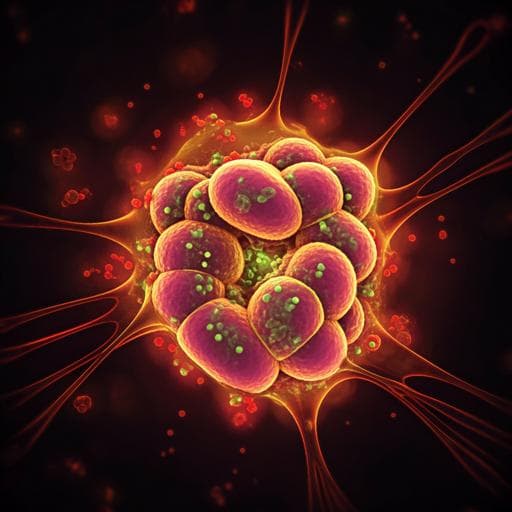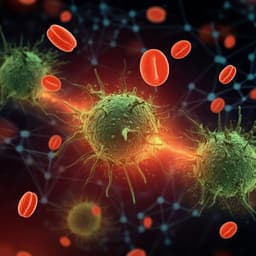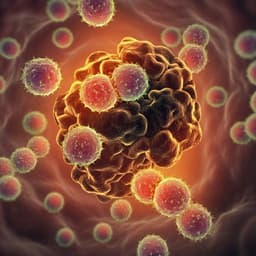
Medicine and Health
TLR5 agonists enhance anti-tumor immunity and overcome resistance to immune checkpoint therapy
C. Gonzalez, S. Williamson, et al.
This groundbreaking study by Caleb Gonzalez, Sarah Williamson, Seth T. Gammon, Sarah Glazer, Joon Haeng Rhee, and David Piwinca-Worms explores how TLR5 agonists like flagellin and CBLB502 can significantly enhance survival rates when combined with immune checkpoint inhibitors against tough cancer types, such as triple-negative breast cancer and melanoma. The findings reveal promising new strategies to tackle cancer resistance and build long-term immunological memory.
~3 min • Beginner • English
Introduction
The study addresses the challenge of primary and adaptive resistance to immune checkpoint therapies (ICT) such as anti-CTLA-4 and anti-PD-1/PD-L1. The authors hypothesize that activating innate immunity via Toll-like receptor 5 (TLR5) agonists (flagellin or its derivative CBLB502) can reprogram the tumor microenvironment to overcome ICT resistance and improve antitumor responses. Using ICT-refractory murine models (4T1 triple-negative breast cancer and B16-F10 melanoma), the work evaluates whether adding TLR5 agonists enhances survival, induces durable immune memory, and identifies blood-based cytokine biomarkers predictive of response, thereby integrating innate and adaptive immune activation to potentiate checkpoint blockade.
Literature Review
Prior work has established ICT as transformative but limited by resistance. Toll-like receptors (TLRs) link innate sensing to adaptive immunity; TLR5 specifically recognizes bacterial flagellin and activates NF-κB signaling to induce pro-inflammatory responses. Preclinical studies have shown antitumor activity of TLR agonists and flagellin-derived agents, and suggest synergy with ICT. Microbiota-immune interactions are implicated in modulating ICT responses. The authors build on these findings to test whether TLR5 activation can shift the tumor microenvironment from immunosuppression to activation, improving outcomes in ICT-refractory settings and exploring cytokines such as G-CSF, CXCL5, and IL-15 as biomarkers.
Methodology
In vitro: 4T1 murine mammary carcinoma cells were stably transfected with an NF-κB reporter (IκBα–Fluc based; pGL4.45-β-arrestin-Luc) to monitor NF-κB dynamics. Cells were stimulated with graded concentrations of flagellin (1 ng/mL–10 μg/mL) or CBLB502 (0.1–25 ng/mL) and imaged every 5 min for up to 4 h on an IVIS 100 system. Reporter dynamics captured initial IκBα degradation (bioluminescence decrease) followed by NF-κB-driven reporter synthesis (signal rebound). Cytokine secretion profiling: 4T1 reporter cells were treated with CBLB502 (1 μg/mL) overnight; conditioned media was analyzed using arrays covering 62 cytokines to quantify fold-changes versus control.
In vivo tumor models: 4T1 TNBC model—BALB/c mice (6–8 weeks) received orthotopic injections of 4T1 FUGW-FL luciferase-expressing cells into the fourth mammary fat pad (with Matrigel). B16-F10 melanoma model—C57BL/6 mice (6–9 weeks) received subcutaneous B16-F10 cells in the dorsal flank. Mice were randomized to vehicle, ICT (anti-CTLA-4 [9D9] and anti-PD-1 [RPM1-14]), TLR5 agonist alone (flagellin or CBLB502), or combination therapy. Dosing/regimens (Table 1): flagellin initial 10 μg i.t. or i.p. then 2 μg i.t./i.p.; CBLB502 initial 10 μg i.t./i.p. then 0.2 μg i.t./i.p.; a low-dose CBLB502 regimen (e.g., 1 μg i.t./i.p. with additional i.p. doses) was also tested; anti-CTLA-4 200 μg i.p. (with subsequent 200 μg i.p.); anti-PD-1 200 μg i.p. followed by 100 μg i.p. (3×). Additional cohorts received higher intratumoral doses of CBLB502 comparable to flagellin. Both intratumoral (i.t.) and intraperitoneal (i.p.) routes were evaluated. Treatment schedules were initiated 2–3 days (B16) or two weeks (4T1) post-implantation depending on experiment.
Bioluminescent imaging (BLI) and tumor monitoring: Mice were imaged weekly (IVIS Spectrum). β-D-luciferin was administered i.p.; total photon flux was quantified. Caliper measurements were used to compute tumor volume (V = L × W^2 / 2). A predictive analysis used week-3 BLI and tumor volume to generate ROC curves (AUC) for survival to 12 weeks.
Host dependency: To test TLR5 dependency, Tlr5−/− and Tlr5+/+ mice bearing 4T1 tumors received CBLB502 (low dose) + ICT, or controls, and survival was assessed.
Immune memory and re-challenge: Long-term survivor mice (tumor-free ≥13 weeks) were orthotopically re-challenged with 4T1 cells contralaterally without further therapy. Survival and tumor burden (BLI, calipers, tumor weight) were recorded. Peripheral blood cytokines were profiled at weeks 3 and 5–7 post-challenge, and at week 3 post-re-challenge.
Peripheral blood cytokine profiling: Sera from defined cohorts (vehicle, treatment failures, long-term survivors; and re-challenge survivors/failures; plus tumor-free and tumor-naïve controls) were analyzed using a Millipore 32-plex panel (including G-CSF, CXCL5, IL-15, etc.). Timepoints included week 3 and weeks 5–7 after tumor implantation and 3 weeks after re-challenge.
Tumor immune infiltrate profiling: At 3 weeks post-implantation, tumors from mice treated for one week (vehicle, CBLB502, ICT, or combination) were harvested, enzymatically digested, and analyzed by flow cytometry. Myeloid populations (CD11b+, Ly6C+, Ly6G+, dendritic cells, macrophages including M1- and M2-like) and lymphoid populations (B cells, NK cells, CD3+ T, CD4+ T, CD8+ T, Tregs [CD4+ FOXP3+]) were quantified. Correlations between immune subsets and Log10 BLI were calculated (Spearman ρ). Statistical analyses included log-rank (Mantel-Cox) and Gehan–Breslow–Wilcoxon tests for survival, ROC AUC for prediction, and appropriate ANOVA/correlation tests for cytokines and infiltrates. All animal work was IACUC-approved.
Key Findings
- In vitro NF-κB activation: Both flagellin and CBLB502 elicited the expected two-phase NF-κB reporter response (initial IκBα degradation with decreased bioluminescence followed by NF-κB-driven increases). CBLB502 demonstrated greater potency and efficacy than flagellin in 4T1 cells.
- In vitro cytokines: CBLB502 (1 μg/mL) upregulated multiple pro-inflammatory and immune-recruiting cytokines (examples: SCF ~97-fold, IL-3/IL-3Rα 8–7-fold, CCL20 6-fold, IL-12 p40/70 5-fold, CCL2/3/9/19, TNF-α, VEGF, G-CSF, IL-2; and increased CXCL1, CCL5, CCL2 significantly; some cytokines decreased such as IL-6). These changes pre-programmed cells toward immune activation/chemoattraction.
- 4T1 TNBC model (ICT-refractory): Flagellin + ICT significantly improved survival versus vehicle (log-rank p = 0.00002; Gehan p = 0.003), whereas ICT alone showed transient benefit (log-rank p = 0.01; all ICT-only mice died by week 8). Flagellin alone was not significant (p = 0.06). CBLB502 (low dose) + ICT yielded 20% tumor-free mice (n = 30) with significant survival benefit (log-rank p < 0.001; Gehan p = 0.001). CBLB502 monotherapy (low dose) produced no survivors; high-dose CBLB502 regimens (alone or with ICT) did not produce cures despite some growth delay; survival differences versus vehicle were detected in some comparisons (e.g., log-rank p = 0.001) without cures.
- Route dependence: Systemic i.p. administration of low-dose CBLB502 did not replicate intratumoral delivery benefits (no survivors), highlighting the importance of intratumoral dosing.
- B16-F10 melanoma (poorly immunogenic): CBLB502 + ICT produced 25% tumor-free mice (n = 39) by week 7–8 (log-rank p = 0.001; Gehan p = 0.003). ICT alone and CBLB502 alone did not significantly improve survival.
- Tlr5 dependency: Tlr5+/+ mice treated with CBLB502 (low dose) + ICT generated long-term survivors (n = 10), whereas Tlr5−/− mice receiving the same combination had no survivors (n = 10) (log-rank p = 0.001; Gehan p = 0.01), indicating host TLR5 is required for efficacy.
- Immune memory: Long-term survivors rejected orthotopic re-challenge, demonstrating durable antitumor immunity.
- Predictive imaging biomarker: Week-3 BLI predicted survival to week ≥12 (AUC = 0.75; 95% CI 0.6–0.9; p < 0.001). Tumor volume AUC = 0.74 (95% CI 0.6–0.9; p < 0.001). Tumor volume slopes were not predictive (AUC ~0.6; not significant).
- Tumor infiltrates vs tumor burden: Higher BLI (worse prognosis) positively correlated with Ly6C+ and Ly6G+ monocytes (r ≈ 0.6–0.7; p < 0.001), and trends for myeloid DCs/M1/NK increases. CD3+ and CD4+ T cells inversely correlated with BLI (r = −0.6; p < 0.001), with trends for CD8+ T, B cells, and macrophage subsets inversely correlated (not all significant). These patterns indicate a shift from myeloid-dominant immunosuppression to T cell–dominant activation in responders.
- Blood cytokine biomarkers: In tumor-bearing mice at weeks 3 and 5–7, low serum G-CSF and low CXCL5 correlated with long-term survival/treatment response, whereas IL-15 was higher in survivors, consistent with engagement of adaptive immunity (NK/CD8+ T). Re-challenge survivors showed similar cytokine signatures (e.g., higher IL-15, trend toward lower G-CSF).
Discussion
The findings demonstrate that engaging innate immunity via TLR5 agonists can overcome resistance to ICT in otherwise refractory solid tumor models. Flagellin and especially the flagellin-derived CBLB502 enhanced anti-CTLA-4/anti-PD-1 therapy, increasing cures and establishing durable immune memory. The requirement for host TLR5 confirms mechanism-of-action through TLR5 signaling. Peripheral cytokine analyses (low G-CSF and CXCL5; higher IL-15 in survivors) align with a model where TLR5 activation reduces myeloid-derived suppressive influences and promotes adaptive immunity (NK, CD8+ and CD4+ T cells). Imaging-based prediction supports BLI as an early biomarker of therapeutic success. Flow cytometry data connecting reduced Ly6C+/Ly6G+ monocytes and increased T cells with lower tumor burden further supports a switch of the tumor microenvironment from immunosuppression to activation. Collectively, TLR5 agonists plus ICT harness innate-adaptive crosstalk to generate durable antitumor responses in ICT-refractory cancers.
Conclusion
This work shows that TLR5 agonists (flagellin/CBLB502) combined with anti-CTLA-4 and anti-PD-1 enhance survival and produce durable cures with immune memory in refractory 4T1 TNBC and B16-F10 melanoma models. Efficacy depends on host TLR5, is associated with early decreases in myeloid suppressors and increases in T cell infiltrates, and correlates with systemic cytokine signatures (low G-CSF/CXCL5; higher IL-15). BLI at week 3 serves as a predictive biomarker of outcome. These results support a therapeutic strategy of intratumoral TLR5 agonism to sensitize tumors to ICT and suggest candidate blood biomarkers for response monitoring. Future work should dissect direct effects of TLR5 agonists on tumor versus immune subsets, optimize dosing/routes, validate biomarkers prospectively, and evaluate translatability to human cancers and the role of the microbiome.
Limitations
- Preclinical murine models (4T1, B16-F10) may not fully recapitulate human tumor immunobiology; findings require clinical validation.
- Some datasets had limited sample sizes, reducing power to detect differences for certain cytokines (e.g., CXCL5 correlations) or immune subsets.
- High-dose CBLB502 regimens did not produce cures and sometimes yielded mixed survival effects, indicating a narrow therapeutic window and the importance of dosing/route (intratumoral vs intraperitoneal).
- Temporal variability of cytokines (weeks 3–10) suggests dynamic physiology; single or limited timepoints may miss relevant kinetics.
- Baseline differences between Tlr5−/− and Tlr5+/+ vehicle survival curves indicate genetic background/host factors can influence outcomes.
- Reliance on BLI and tumor volume as surrogates, while informative, may not capture all aspects of antitumor immunity and microenvironmental changes.
- The study did not fully delineate whether TLR5 agonists act directly on tumor cells versus immune compartments in vivo, nor their specific effects on adaptive subsets beyond correlative analyses.
Related Publications
Explore these studies to deepen your understanding of the subject.







